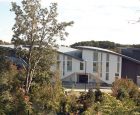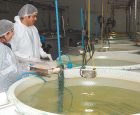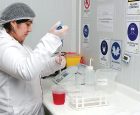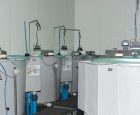
Features
Profiles
Joint venture forms salmon research hub in Chile
Since it was built in 2012, the Aquaculture Technology Centre (ATC) Patagonia held the genetic improvement program of Aquachile – which used to be the largest salmon producing company in Chile. Last year, before Agrosuper purchased Aquachile, Danish feed company Biomar acquired 30 percent of this facility and helped turn it into one of the largest experimental stations of its kind.
November 9, 2018 By Christian Pérez Mallea
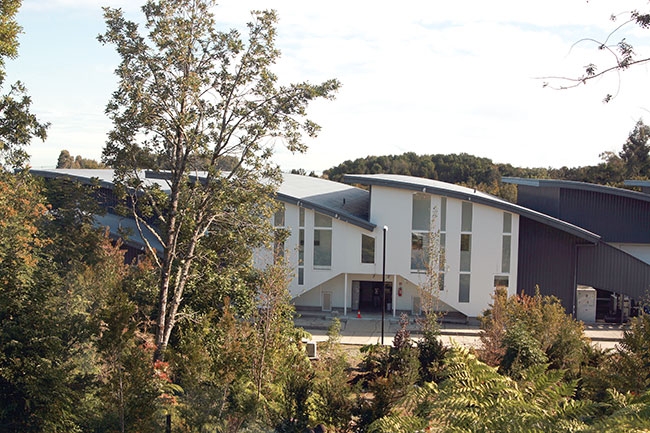 Exterior view of ATC Patagonia Since it was built in 2012
Exterior view of ATC Patagonia Since it was built in 2012Part of that transformation process includes a significant change in the layout, dividing the ATC building into 17 modules instead of the original four rearing rooms, for example, as well as creating biosecurity and operational protocols intended to keep all areas separated.
Located 33 kilometers east from Puerto Montt, beside the river Lenca and next to the shoreline, the ATC Patagonia has so far required US$13.5 million in investments in its 2,000-sq.m. constructed area.
“The location of ATC Patagonia, which is close to Puerto Montt, allows us to be close to the city where most of the local aquaculture community is located, but also far away enough to ensure a quiet operation,” the centre’s general manager, Pablo Ibarra, says. “The place is also nearby the marine coast and adjacent to a freshwater river providing both water sources in enough quantity and quality. In addition, it is in a very satisfactory natural environment.”
This experimental fish farm belongs to Aquachile’s holding, and opened in late 2012. Given the need to speed up research and development processes for the local aquaculture and salmon industry, the centre opened its doors in 2013. The availability of the ATC facility allowed other companies to test their products “in a controlled environment with the most advanced technology available and specialized infrastructure for this purpose,” says Ibarra. Among other services, both nutritional and fish pathogen trials are offered.
As for Biomar Chile’s acquisition of part of this facility, the company’s general manager, Eduardo Hagedorn, comments, “we are proud to secure an initiative of this level and scope in Chile. Biomar is continuously making efforts to improve its capacity for innovation. Without a doubt, ATC Patagonia is going to generate a positive impact on the development of food worldwide.”
Installed capacity
ATC Patagonia has 10 production rooms, 17 recirculating aquaculture systems (RAS), 312 tanks of 11 different types, and 11 biosecure access points, among other elements. With a total farming volume of 371 cu. m., the facility features automated systems and controls over several environmental variables.
Basically, this farm consists of independent modules of different sizes, oriented to make experimental designs for all types of products that need to be tested. All modules have an independent biosecure access, dressing rooms, bathrooms for the staff and laboratory, an area for rearing tanks with adequate numbers to enable experimental replicas, and a water treatment system that allows for the RAS operation.
The tanks range from 10 liters to 15 cu. m. in nine different sizes, which allow tests from first feeding to harvest weight. The number of tanks can vary from six to 36 per module. The treatment system allows both freshwater and seawater operatios, and its mixing at the desired value. The system also provides temperature control from 6 to 24°C; control of solids by drum filters and skimmers; control of oxygen, gases and carbon dioxide; biofiltration; and disinfection by UV filters in all its units.
Since this is an experimental station, operation parameters for both water exchange in all systems and replacement rate in tanks can be adjusted according to each experimental design. Likewise, all systems can operate through re-use rate replacement (50-70 per cent), as well as in full recirculation. Moreover, the small modules can operate at open flow with temperature control.
Variety of trials
The diverse setting of rooms and equipment is ideal for a variety of trials to be performed, from nutritional tests to challenges with pathogens, tests of vaccines both injectable and via immersion. Security tests, verification of withdrawal period or validation for commercial registration of products are part of the offer too. Additionally, tests with parasites such as infestations with sea lice can also be conducted at the facility. Likewise, short-term trials to determine efficiency of veterinary or nutritional products, as well as performance tests or search for immunological expression in long-term trials, are also among the facility’s capabilities.
ATC Patagonia is prepared to perform trials on RAS for the three salmonid species farmed in Chile (Atlantic salmon, Coho salmon and Rainbow trout), including the fattening stage in all of them. Therefore, all farming conditions can be replicated there.
Among other studies, vaccines have been evaluated, genetic challenges performed, and diets analyzed under the highest standards. “Our goal is to contribute with more and better products for the Chilean salmon industry which seeks, every day, progress in terms of sustainability,” Ibarra says.
The facility is operated by 45 staff members composed of professionals and technicians, the general manager says.
“They allow us to operate the 17 modules available simultaneously, considering we have maintained a constant operation of between 11 to 17 simultaneous trials,” says Ibarra. Most of these professionals working at ATC Patagonia are from the aquaculture, veterinary and maintenance industries. “We have technical personnel specialized in fish handling and at obtaining specific samples required in productive-scientific trials,” he adds.
Print this page
Advertisement
- Cermaq researcher could help improve mitigation of fish diseases
- New RAS facility in Norway to produce 3.2 million post-smolts annually
